Unlocking the Secrets: 15 Ways to Optimize Digestive Health & Nurture Your Gut Microbiome.
Updated at: 2025-05-07 06:27:47 (2 months ago by Melkisedeck Leon Shine)
Optimizing Digestive Wellness: A Holistic Approach to Gut Microbiome Flourishing
Optimal digestive health forms the cornerstone of overall well-being. The gut microbiome, a complex ecosystem of microorganisms residing within the gastrointestinal tract, plays a crucial role in nutrient absorption, immune function, and even neurological processes. Cultivating a thriving gut microbiome is not solely dependent on restrictive dietary regimens; rather, it necessitates a holistic approach encompassing mindful dietary choices and lifestyle modifications that synergistically support the body's intrinsic processes. This article presents fifteen evidence-based strategies designed to foster a flourishing gut microbiome and enhance long-term digestive wellness.
1. Dietary Diversity and the Principle of Microbial Niche Construction: A balanced diet, incorporating a wide spectrum of fruits, vegetables, whole grains, lean proteins (e.g., fish, poultry, legumes), and healthy fats (e.g., avocados, nuts, olive oil), constitutes the foundation of a robust gut microbiome. This nutritional diversity, in accordance with the principle of microbial niche construction, provides varied substrates for the growth and proliferation of a diverse range of beneficial bacteria, thereby fostering a resilient and adaptable intestinal ecosystem. A lack of diversity can lead to dysbiosis, an imbalance in the gut microbiota associated with various health issues.
2. Fiber as Microbial Fuel: Promoting Gut Motility and Symbiotic Relationships: Dietary fiber serves as a prebiotic, providing essential sustenance for beneficial gut bacteria. The inclusion of fiber-rich foods (beans, lentils, whole grains, fruits, vegetables) in the daily diet promotes the growth of beneficial microorganisms and facilitates regular bowel movements, preventing constipation. This underscores the symbiotic relationship between diet, gut microbiota, and overall gastrointestinal health. Regular bowel movements are crucial for eliminating waste products and maintaining intestinal integrity.
3. Hydration and Digestive Physiology: Adequate hydration is paramount for optimal digestive function. Water facilitates the breakdown of food, promotes efficient waste elimination, and maintains the integrity of the gastrointestinal mucosa. Dehydration can impede digestive processes and lead to constipation, further highlighting the importance of consistent hydration throughout the day.
4. Minimizing Ultra-Processed Foods: Impact on Gut Dysbiosis: Ultra-processed foods, characterized by high levels of unhealthy fats, added sugars, and artificial additives, are often implicated in gut dysbiosis. These foods can negatively alter the composition and function of the gut microbiome, leading to an imbalance and potential inflammation. Prioritizing whole, unprocessed foods provides the body with the essential nutrients needed to support a healthy gut environment.
5. Stress Management and the Gut-Brain Axis: Chronic stress exerts a considerable impact on gut health via the gut-brain axis. Stress hormones can disrupt digestive processes and potentially exacerbate existing digestive disorders. Implementing stress-reduction techniques (meditation, yoga, deep breathing exercises, regular physical activity) promotes a calmer gut environment and improves overall well-being. The gut-brain axis highlights the intricate connection between the central nervous system and the gastrointestinal tract.
6. Moderate Alcohol Consumption: Minimizing Gastrointestinal Irritation: Excessive alcohol consumption can damage the gastrointestinal lining and disrupt the gut microbiota's delicate balance. Moderate alcohol intake, if any, is recommended to minimize potential negative effects on digestive health. This aligns with responsible health behaviors.
7. Limiting Added Sugars and Artificial Sweeteners: Impact on Gut Microbiota Composition: Excessive consumption of added sugars and artificial sweeteners can selectively promote the growth of harmful bacteria in the gut, leading to an imbalance and potential digestive distress. Limiting these substances and prioritizing whole food sources of natural sweeteners are advisable for gut health.
8. Probiotics: Augmenting Beneficial Gut Microbiota: Probiotics, live microorganisms with potential health benefits, can positively influence the gut microbiome composition. Dietary sources (yogurt, kefir, kimchi, sauerkraut) or high-quality supplements (under medical supervision) can be used to increase the abundance of beneficial bacteria. However, appropriate selection and dosage should be guided by medical professionals.
9. The Role of Mastication in Digestive Efficiency: Thorough chewing is essential for efficient digestion. It mechanically breaks down food, increasing surface area for enzymatic action and improving nutrient absorption. This initial step in the digestive process, occurring in the mouth, significantly influences the overall efficiency of the digestive system.
10. Regular Physical Activity and Gut Motility: Regular physical activity stimulates gut motility and improves overall digestive function. Moderate-intensity exercise (at least 30 minutes most days of the week) helps maintain a healthy gut microbiome and supports overall health. This aligns with established physical activity guidelines for health benefits.
11. Sleep Quality and Gut Microbiome Regulation: Sufficient sleep is crucial for the regulation of the gut microbiome. Sleep deprivation can negatively alter the composition and function of the gut microbiota, potentially contributing to digestive problems. Aiming for 7-9 hours of quality sleep per night is important for supporting the body's natural restorative processes.
12. Judicious Antibiotic Use: Preserving Gut Microbiota Diversity: While antibiotics are vital for treating bacterial infections, their overuse can significantly disrupt the gut microbiome. Antibiotics should only be used under medical guidance, and strategies to support gut health during and after antibiotic therapy should be considered. This minimizes potential harm to the beneficial bacteria.
13. Fermented Foods and Gut Microbiome Diversity: Fermented foods (kefir, kombucha, miso) contain a rich array of beneficial bacteria and contribute to a more resilient gut microbiome. Including these foods in the diet promotes a more diverse and robust intestinal ecosystem.
14. Prebiotics: Nourishing Beneficial Bacteria: Prebiotics, non-digestible fibers that serve as substrates for beneficial bacteria, promote their growth and proliferation. Incorporating prebiotic-rich foods (garlic, onions, bananas, asparagus) enhances the gut environment, fostering a thriving microbiome.
15. Personalized Nutrition and Individualized Gut Response: Individual responses to dietary components vary. Paying close attention to the effects of different foods on digestion and overall well-being allows for personalized dietary adjustments to optimize gut health. This emphasizes the importance of individual dietary tailoring.
Conclusions and Recommendations: Optimizing digestive health is an ongoing process requiring a holistic approach. The fifteen strategies presented above, rooted in established scientific principles, provide a framework for cultivating a thriving gut microbiome. A multidisciplinary approach, involving healthcare professionals and registered dietitians, can provide personalized guidance tailored to specific needs and health conditions. Future research should focus on further elucidating the complex interplay between diet, lifestyle, and the gut microbiome, ultimately leading to the development of more effective interventions for promoting optimal digestive health and preventing related diseases. The long-term impact of these strategies extends beyond digestive wellness, affecting overall physical and mental well-being. The applicability of these strategies is broad, encompassing individuals seeking to improve their health and healthcare professionals aiming to promote personalized, evidence-based care.








